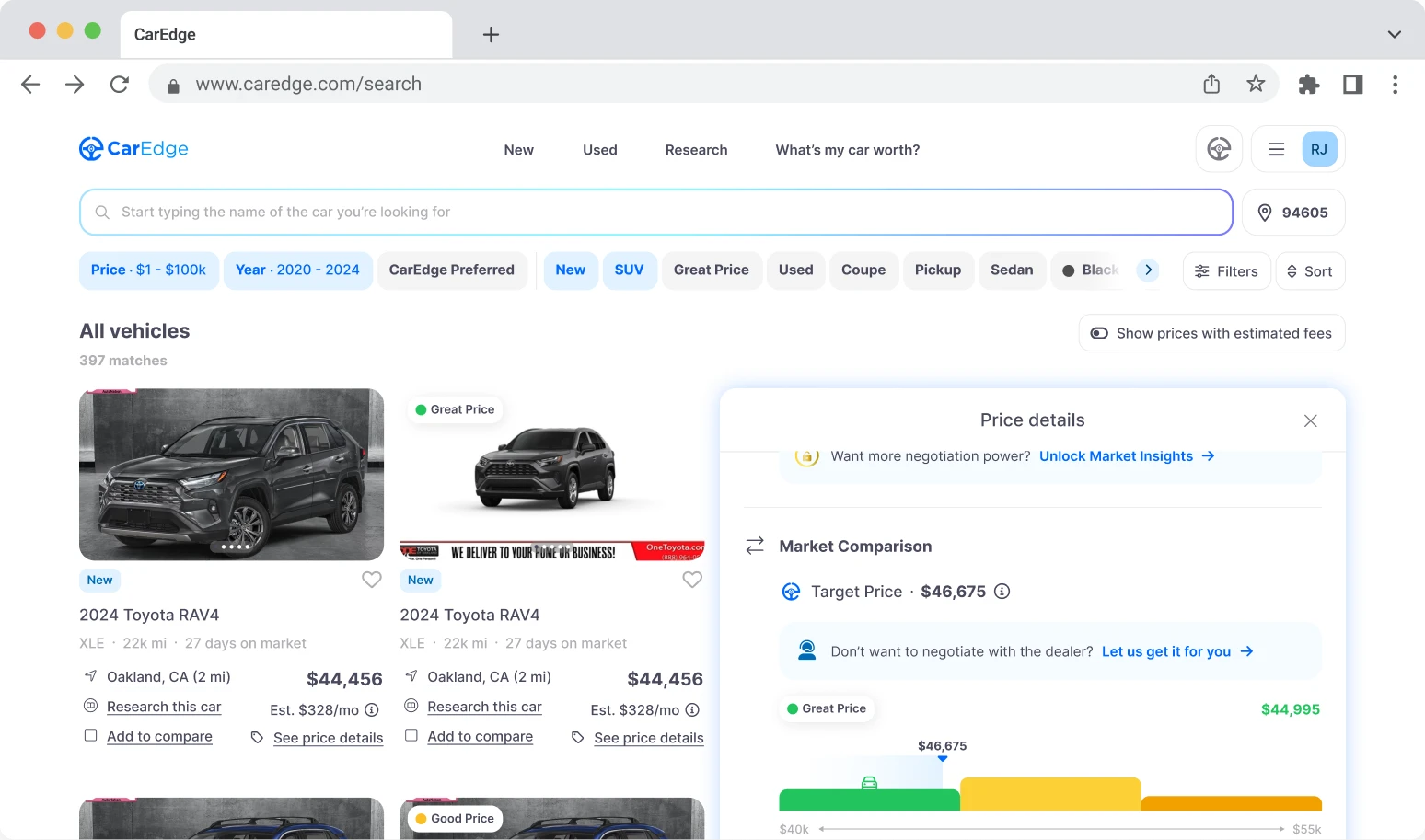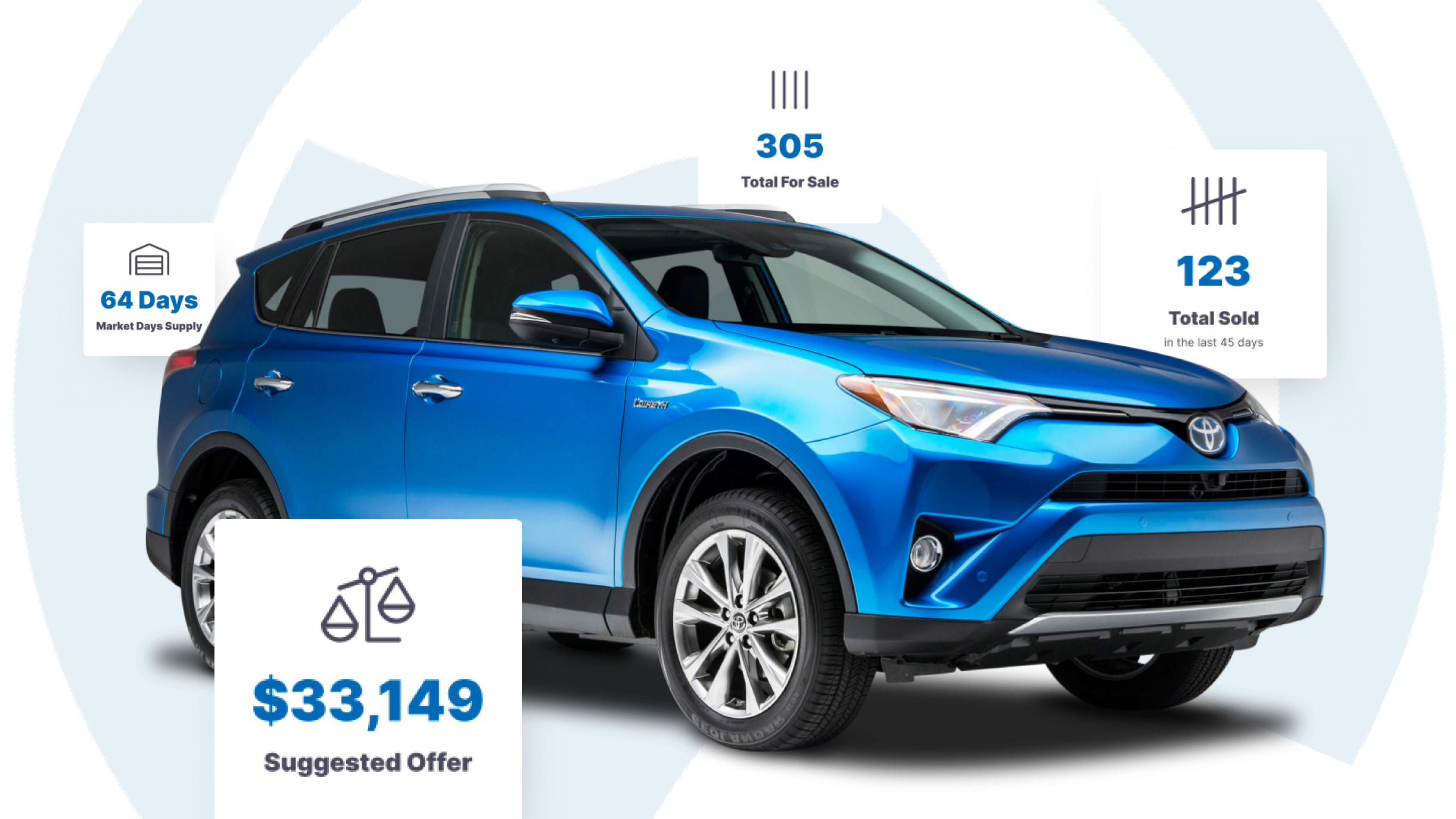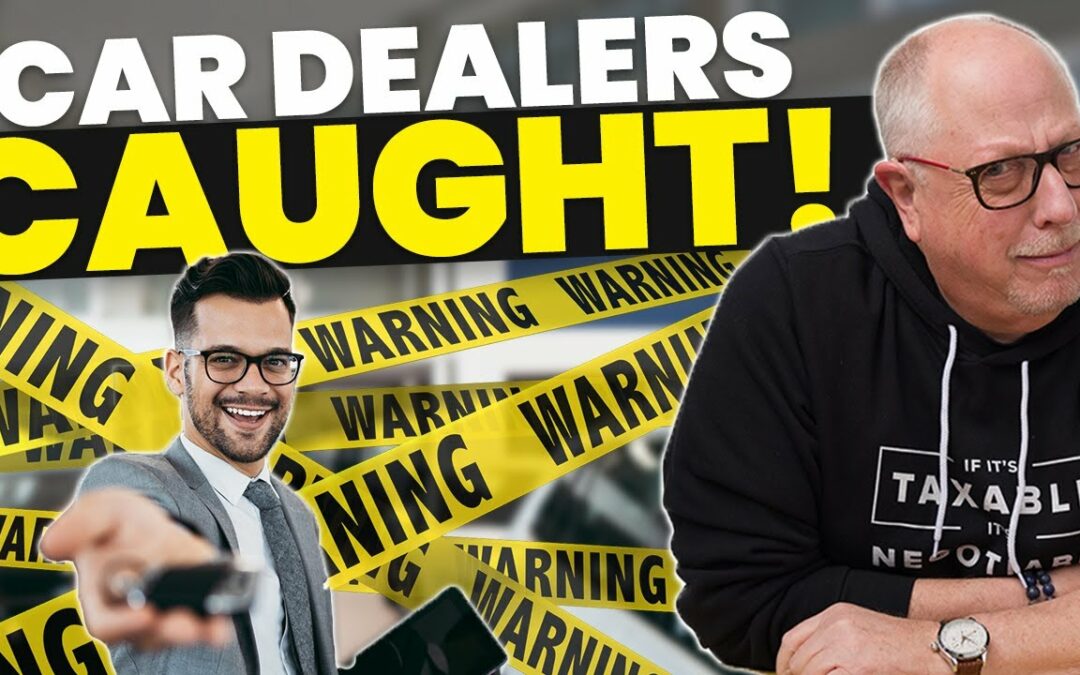CarEdge saved me over 4,500 dollars on a brand new Honda Pilot. I can't say thank you enough.
Price intelligence
Find a wide range of vehicle listings with market insights on new and used listings near you.


Help us personalize your CarEdge experience — it only takes a second.
Your answers help us personalize your CarEdge journey — we’ll follow up with tips and next steps that match your buying timeline.

When you go to buy a car, don’t be surprised if the dealer you’re purchasing it from bought the car at an auction. The “ins and outs” of used car auctions remain unknown to many, however they aren’t too terribly complex. Many people have asked me “why do cars go to auction?”
The short answer for why cars go to auction is to improve dealership profitability.
Let’s explore how car dealerships work, and how you can make an informed decision armed with this knowledge.
Car dealers are in the business of making money. When they can’t sell a car to a consumer quickly, it’s more profitable for them to sell that car to another dealer via an auction. Generally speaking, dealerships make most all their decisions based off of how it will impact their profitability.
As pre-owned inventory ages, dealers will often take those vehicles to the auction. Their goal is to turn that “dead” inventory into cash that can be used to buy other cars that they expect to sell faster. But why do dealers do this in the first place? What incentive do they have to get rid of “dead” inventory?
Most dealerships have strict pre-owned aging policies. This means that internal policies dictate how long a used car can stay on a dealership’s lot before it gets sent to the auction. A common practice in the industry is the 60 or 90 day rule.
If a used car isn’t sold within 60 or 90 days (this varies from dealer to dealer) management staff must get rid of the car. They have two options; either wholesale the car directly to another dealer, or more likely sell it at an auction.
Sometimes dealerships will even send new cars that have not sold quickly enough to the auction. This doesn’t occur often, but it happens. The rationale is for dealerships to relieve themselves of excess new car inventory or aging new cars, and instead replace them with fresh merchandise that they think will sell more quickly to a consumer. The whole reason cars go to the auction is to ensure inventory balance at the dealership.
Cars go to used car auctions because dealers simply can’t sell them quickly enough to a customer at their storefront. Dealers are incentivized to sell cars sooner rather than later because of carrying-costs that diminish a cars profitability, and pressure from shareholders to show that they’re moving inventory quickly.
If a dealership isn’t turning their inventory it is a sign to shareholders that they aren’t as efficient or profitable as their peers. With inventory sitting on a lot, the dealer has a significant amount of capital tied up in cars that aren’t selling. That means their money isn’t making them as much profit as it could.

Dealership staff accumulate knowledge and experience over time. With that experience comes the ability to know which makes and models will or won’t sell at their dealership. Prior experience with certain makes and models may have shown that certain cars simply aren’t popular on their lot. Off to the auction they go.
This varies from dealer to dealer. Location can play a major role in determining which cars stay and which cars go. For example, a sports car that gets traded in to a rural dealership will likely get sent to auction.
Sometimes a dealership will trade a luxury car that is simply too expensive for their taste. Those cars will be sent to an auction that specializes in those types of vehicles.
Another reason why cars go to auction is that after inspecting a vehicle for road worthiness and determining how much it would cost to recondition the vehicle, the dealer may simply deem it too expensive. When that’s the case, off to the auction it goes.
Often times dealerships trade cars that are too old, or have too many miles. When this is the case, a dealer may have no real intention of keeping the car. Instead they simply ship the car off to the auction as soon as possible.
As you can see, there are no shortage of reasons why cars go to auction. Dealerships send cars to the auction to get rid of aging inventory, because they just want cash to buy something different, or merely to balance their inventories for maximum return of investment. The reasons are as valid as they are varied, and the auctions remain a valuable tool for dealerships to use.
NEW from CarEdge: Get your FREE Dealer Invoice Price in minutes!
Knowing what to bring with you when buying a car can be one of the most intimidating aspects of the process. You know you’re serious about buying a new car, but you aren’t 100% sure what documents you need to have with you when you step foot in a dealership. That’s a-okay. We’ve all been there before.
What to bring with you when buying a car depends on your situation. Are you trading a car in? Financing your car? Do you have a co-signer? There are certain things you’ll want to have with you when you go to the dealer.
Let’s dive into each of the items you should bring with you when buying a car.

If you have a car to trade in, bring the title (if you have it), and make sure the car is titled in your name. A lot of people don’t realize that you can’t trade in a car that isn’t titled in your name. That means if you’re married you can’t trade in a car titled in your wife’s name without your wife being there. The name on the title and registration must match, if they don’t you can’t trade it in.
Also, don’t forget all sets of keys! Most cars have two sets of keys, unless one was lost.
If the vehicle is paid off, bring all the documents to confirm that the loan has been paid, and bring the current registration and valid insurance card. Oh, and don’t forget your driver’s license.
These are your “must haves” for trading in a car.
If you plan on putting money down on your new car, bring your checkbook or debit or credit card.
If you’re going to use your debit card for the down payment, make arrangements with your bank beforehand to allow you to access the amount of money you plan to put down. Most checking accounts have daily spending or withdrawal limits. The last thing you want to do is hand your debit card to the dealer for it to only get rejected when they swipe it. Make arrangements with your bank prior to getting to the dealership to ensure the smoothest process possible.
If you plan to use your credit card for your down payment, find out from the dealership the amount that they will accept that way. Since merchants pay a bank fee to process credit cards (2% or more of the amount charged), dealerships will limit the amount they accept from a credit card. In my 42 year career I saw dealerships that only accepted $1,000 from a credit card to go towards a down payment, to a max of $5,000 at some dealerships.

👉 Finance your car like a PRO with this free cheat sheet!
If you will be financing or leasing your new car, bring the information you’ll need to complete your credit application. This includes:
You might also enjoy this article if you haven’t read it already: What Credit Score Do Car Dealers Use?
The more complete the credit application, the quicker it is for the bank to make their determination as far as your credit worthiness is concerned. What does that mean for you? If you want to get in and out of the dealership as quickly and painlessly as possible, bring this information with you and have it handy.
Here is an added bonus that you should bring with you when buying a car. Bring a good attitude.
I know it might sound cliche, and hell, it is cliche, but after doing what I did for 42 years, I can assure you it goes a long way.
When you arrive at the dealership, let the salesperson know what you hope to accomplish together during your visit. For example, if you’re just there for information gathering, tell them that. If you’re only going for a test drive today, that’s a-okay, let them know. You simply want info on incentives and programs? Great, thanks for letting me know!
Don’t be adversarial, buying a car is truly a collaborative effort. Finding the right car and the right terms is a team effort, and the better you work as a team, the easier and more pleasant it will be.
So there you go. It isn’t as daunting as it may have seemed at first. If you bring these few items with you when you go to buy a new car, you’ll have a more pleasant experience. I guarantee it!
“I got a great deal.”
“How do you know?” I asked?
“Well, I negotiated over $2,000 off the original price, so I’m pretty sure I made out well. Didn’t I?”
After doing this for as long as I have, it doesn’t take long to burst someone’s bubble.
“Maybe you did… I know when I was managing dealerships I told my salespeople that they needed to be ready to lower the price three time during a negotiation — the customer always likes to win three times, then they’ll buy the car.”
I don’t take pride in bursting their bubble, it just comes with the territory at times.
“So, in your case, that $2,000 you shaved off the price is certainly some hefty savings, but I’d venture it was baked into the price they initially quoted you.”
The look on my son’s friend’s face was starting to sour.
“Don’t fret though, I’m sure they only made a couple hundred or maybe a thousand dollars off your deal, it’s just there may have been more room to negotiate.”
In today’s internet era, you may feel like you know how much wiggle room there is to negotiate on a new car, but at the end of the day, as a consumer, it’s hard to really know. Sure, tools like Kelly Blue Book can help you understand what a car is worth, but KBB and others miss out on vital pieces of information (such as manufacturer incentives, how long a car has been on the lot, and more).
When it comes to knowing how much you can negotiate on a car purchase there are 3 vital pieces of information that I always look for, and if I were you, I’d do the same.
Let’s explore each one of these.
You might also enjoy this article if you haven’t read it already: How Much Do Dealers Markup Used Cars?

The window sticker is the Manufacturers Suggested Retail Price, hence MSRP. What you need to find out is the percent of margin built into that MSRP. For example, for many less expensive cars (Toyota, Hyundai, etc.) the percent of margin (markup) might be very little, as little as only 2 or 3% of the MSRP.
It’s important to understand that the dealer buys the car from the manufacturer at the invoice price, and then lists the car for sale at or near the MSRP price. This is the retail price.
That means a car with an MSRP of $18,000 might only have $360 of profit built into it.
👉 Get the window sticker for free (don’t let others charge you for this!)
Generally speaking, and as a rule of thumb, the more expensive and luxurious the car, the more margin is built into the retail price. Where an $18,000 car may only have $360 of profit built into it, a $100,000 car may have as much as $10,000 in margin.
How can you determine what the dealers mark up on a car is? Unfortunately, it isn’t an exact science because it changes from car to car and dealer to dealer. However, you can use the guideline of 2 or 3% on less expensive brands, and 5 to 10% on luxury brands as a rule of thumb.
Regardless of if you’re buying a Kia or a Mercedes, the reality is there isn’t too much room to work with when just looking at the mark up. This is where factory incentives come into play.
Dealer incentives (also commonly referred to as factory incentives) are put in place by the manufacturer and allow for greater price flexibility because they artificially inflate the margin on any given car. The percent of margin in new cars can range from a low of 2% to as high as 15%, including all incentives.
The internet is a wonderful tool for finding information on incentives for particular cars. Bear in mind that there can be two types of incentives; customer incentives and dealer incentives.

Customer incentives range from rebates to special loan interest rates. Rebates can be as little as $500, or as much as $10,000 depending on the brand and the model. Other customer incentives can take the form of recent college graduate programs or active military or retired military and first responder programs.
There can also be hidden incentives based on who you work for or where you graduated college. Always ask the dealer about these types of programs and incentives, because it doesn’t cost them a dime! These programs and offers are usually through the manufacturer, so the dealer has no reason not to assist you here.
Customer incentives are relatively easy to learn about. Manufacturers actively market their recent college graduate programs, and websites like Edmunds.com keep track of constantly changing rebates and incentives.
Dealer incentives on the other hand are much harder to know about, and they can greatly affect how much you can negotiate on a new car. Manufacturers have monthly, quarterly, and even annual sales incentives for their dealers.
You need to understand that manufacturers have one objective, and that is to sell as many cars as possible. Many manufacturers are public companies. That means that each quarter they need to share their finance metrics with shareholders. Shareholders want to see that manufacturers are growing and selling more cars.
With that understanding, it’s easy to see why manufacturers put sales incentives in place for their dealers. Manufacturers need dealers to move as many cars as possible so that the manufacturer’s shareholders are excited about the brand’s growth.
Dealer incentives are quite significant. For example, a BMW dealership that hits their monthly sales incentive could receive $50,000 to $200,000 from the factory depending on their sales volume.
Obviously this means the dealer will be happy to lower the price on a car so that they get the kickback from the manufacturer. Use this to your advantage! Always ask the dealer how close they are to hitting their goal, if they need one or two more sales to get there, guess who just picked up some leverage? Yep, you!
The third criteria to know how much you can negotiate on a new car is how long the vehicle has been sitting on the dealers lot. The age of a car, and specifically how long it has been at a dealership can drastically affect a dealers willingness to discount a car.
If you’re looking for the car with the most “wiggle room,” then ask the dealer for the oldest inventory.
You might also enjoy this article if you haven’t read it already: What Happens to Unsold New Cars?
The reason for this is quite simple, the longer a car sits on a dealer’s lot the more it costs them (we talk about carrying costs in this post). This increases the dealers incentive to sell the car, and ultimately to save you more money.
By showing your interest in their oldest car, you’ll immediately get their attention. Make it clear you’re willing to entertain the “old” car if they make the price less than a younger (a similar car that has spent very little time in inventory). I can assure you from my 42 years of experience, they’ll be happy to do this for you.
Cars, unlike fine wines, don’t necessarily get better with age. Dealers want “old” cars gone! That gives you leverage, and getting a good deal is all about leverage.
So, now that you have some inside information you should feel more comfortable negotiating your next car deal. However, if you are like the majority of people that just hate to have to deal with this type of negotiation, there is help for you. Learn more about buying with CarEdge. We do the negotiating for you, and have your car delivered to your door.
👉 Check out this month’s best new car incentives (0% APRs, lease deals, and more!)

It’s always upsetting to learn that someone’s overcharged you for something. When I was asked “What can you do if you’re scammed by a car dealership?”, I knew I had to answer it.
Legitimately, if you’ve signed all the documents, completed your purchase, and driven your new car home, legally, in most jurisdictions, there isn’t much of anything you can do. In the eyes of the law, you’re the owner of that car. That doesn’t mean there aren’t practical steps you can take to try and resolve the issue, however.
If you feel that may have been taken advantage of, overcharged, or outright scammed, here’s the steps I would recommend you take.
Once you’ve realized something fishy happened, you may want to immediately call your salesperson. I wouldn’t recommend doing that. The salesperson isn’t going to be able to do anything to help resolve this issue, and they probably won’t want to if they did something nefarious.
You’ll want to talk to the sales manager, or better yet, the general manager (GM). When you do get through to a manager, the first thing you should try and do is appeal to them to “do the right thing.”
Don’t threaten or yell at the GM. In my 42 years in the car business, rarely did I see this tactic pay off. Car people are real people, just like you and me. They have families, and friends, and they can be swayed to help people in need.
Start out by approaching them as a human being and appeal to them on a human level. Ask them to do what is morally right. You might frame it exactly like that by saying something along the lines of, “Rarely in life can we make a wrong right, but now is one of those opportunities.” If you were legitimately scammed by a dealer, this tactic should work.
Be prepared to explain what the issue is and provide what you think would be a fair solution. The last part is critical. Come prepared with what you think would be a fair resolution to the problem.
By providing a solution, you are showing the GM good faith. This will encourage the necessary conversation that will ultimately lead to an acceptable resolution for everyone involved.
My experience has shown that this type of approach usually leads to a reasonable resolution. Personally, and during my 42+ year career in the car business, I am (and always was) more inclined to help a friendly person solve a problem than a screaming, threatening person.
Do you ever wonder how much car dealers mark up used cars? You might enjoy this article if you haven’t read it already: How Much Do Dealers Markup Used Cars?
If presenting your issue to the general manager doesn’t resolve the problem, your next best bet would be to contact the managing partner, dealer principal, area vice president or the owner of the dealership.
I can tell you from experience that if I couldn’t resolve a customer issue at my level, and it made it up the ladder to someone of greater authority, they were going to do whatever they had to do to make the problem go away. The dealer principal, vice president, or owner is too busy with other things to really want to deal with you. Use that to your advantage!
When I worked for the Penske organization, we had a regional VP that always reminded us that if a customer issue ever reached him, he would do whatever he had to do to make the customer happy. His advice to us (his managers) was to simply handle the issue at our level so he wouldn’t have to.
With that being said, if you weren’t able to resolve the issue with the general manager, do your best to talk to the next level of authority. They’re likely to do whatever it takes to “make the problem go away,” and considering you want a fair resolution, this is one way to get it. At most dealerships you can identify this person on their website. If you can’t, call the receptionist and ask.
What if “talking it out” doesn’t work? Do you still have options if you were scammed, overcharged, or taken-advantage of by a car dealership? The answer is yes.
You can contact the Better Business Bureau, your state’s Consumer protection Office, or even the Attorney General’s office. These three options could be time consuming. However, the Better Business Bureau would try to broker a resolution in a more timely manner than the other two would.
The Office of Consumer protection and the Attorney General’s office generally want to see a pattern of abuse by a dealership before taking action. You may need to wait years for enough complaints to be filed before they will do anything. This is frustrating, but it’s the reality of the situation.
The court of last resort, so to speak, is social media. There are any number of sites where you can post a review of the dealership and share your experience. Once again, do it in a respectful manner, no name calling, no shouting, no threats, as Sergeant Joe Friday from the old TV show Dragnet would say, “just the facts ma’am, just the facts.”

Although it may feel “good” to write out a diatribe, do your best to be succinct and factual in your online review. This will more than likely elicit a positive response from the dealer management. Dealers want to protect their online reputation. This means they’ll usually want to make amends for their wrongdoing to encourage a more positive review from you.
So what should you do if you’re scammed by a car dealership? Whether be an overcharge, a bait and switch, or something in between, realize that you might not have legal standing for your issue, but you do have options as to how to address it. From my experience, these are the avenues I suggest you travel if you ever find yourself feeling taken advantage of at a car dealership.

Ready to achieve more than simply avoiding scams, and outsmart the dealerships altogether? Enroll in Deal School now—CarEdge’s online, completely free car-buying course. Gain the insider knowledge to take charge of your purchase. Start mastering your deal today! It’s FREE HELP!

Do you ever wonder why car dealers are always trying to buy your car? It has something to do with how much dealers markup used cars. There is a lot of money to be made in used cars.
In my career, I’ve seen many different ideas about what the markup should be for a used car. There are many factors to consider. Let’s breakdown how dealers determine their price for used cars, and how much markup they apply to come up with the selling price.

Where to start? With a quick history lesson.
In the old days (you have to remember, I spent 42 years in the car business),pricing in the good old days was simple, easy, and best of all, it worked.
When a customer would walk in we knew how much profit was in the list price. We’d negotiate, and end up selling the customer their used car with a profit of $1,000 or $2,000. The best part was, the customer felt like a winner because they negotiated us off of our original price, and we made money.
Today it’s completely different. Today’s car buyers have access to more information before they walk in.
On the other side of the deal, car dealers today have software that helps them determine how much a car is worth. These software programs are complex. They tell dealers what they should price each used car at in relation to similar cars in the market so that they’ll sell. They can even take into account geographic and seasonal differences between dealerships.
Pricing for profit isn’t the primary concern for most car dealers. Even more important than profit nowadays is how quickly a dealership can turn its inventory. Turn is the term used to describe the amount of time a car sits on a dealers lot before it’s purchased by someone.
For many dealers (especially the big ones), the idea is to sell or turn your inventory within 60 days of acquiring it.
Many stores have strict aging policies for their used cars. If a used car doesn’t sell within 60 days (or at the max 90), off to the auction it goes. The dealer will sell a used car at auction and replace it with a different car that they think will sell within the 60 to 90 day timeframe. For most dealers, it’s important to turn your inventory as fast as possible. As a car sits on the lot, its actual value is declining. From the dealer perspective, what was worth $10,000 when you traded it is now worth $9,000 90 days later.
The longer a car sits on the lot, the lower the selling price becomes.
Most dealerships work on a strict 60 to 90 day policy for their used cars. This means they’re adjusting a used cars price downward every 10 days to try and sell the car.
There is even software that tracks how much interest a used car gets and changes the list price in realtime. Dynamic pricing decisions occur on an almost daily basis.

As much as the market will bear for that model. With that advent of sophisticated software platforms and “big data,” we’re seeing more and more dealers allowing algorithms to set prices, rather than human beings.
Last year, one iSeeCars survey showed that 31% of car buyers are paying over MSRP for new cars. At the used car level, it’s harder to collect similar data, but just imagine the markups running rampant.
That being said, the average used car markup today is probably about $2,500. Hard to find specialty cars (Ferrari, Lamborghini, McClaren and others), or models in short supply could (and should) be much higher. But, for your run of the mill used car, expect the dealer to have a $2,500 markup in the price. Remember, to get the best deal, you’ll want to find one of the older cars on the lot!

Ready to outsmart the dealerships? Download your 100% free car buying cheat sheets today. From negotiating a deal to leasing a car the smart way, it’s all available for instant download. Get your cheat sheets today!